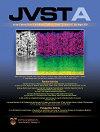Electron-enhanced high power impulse magnetron sputtering with a multilevel high power supply: Application to Ar/Cr plasma discharge
IF 2.1
3区 材料科学
Q3 MATERIALS SCIENCE, COATINGS & FILMS
引用次数: 0
Abstract
A high-power impulse magnetron sputtering (HiPIMS) power supply, called e-HiPIMS, has been developed and used to deposit chromium thin films within an argon discharge. This power supply comprises three stages; each can deliver a voltage pulse up to 300 V. The advantage of this power supply is the possibility of tailoring a pulse waveform on the cathode with several voltage levels. This e-HiPIMS can operate in the standard HiPIMS mode (s-HiPIMS) and multipulse HiPIMS mode. Each voltage sequence is independently managed regarding the width, delay, and voltage level. They can all be synchronized, giving the s-HiPIMS, or shifted in time and added to each other. Hence, the idea is to favor a specific ion population compared to others, according to the process needs and the targeted application. A beneficial example used a three-pulse sequence with different voltage levels. The influence of the temporal behavior on the plasma parameters, namely, currents and electron energy, has been studied for each pulse sequence. The results show that the discharge current stays within the same order of magnitude as in the standard HiPIMS. The reference current level can be obtained quickly, adding a short over-pulse, even if its voltage level is relatively low. Furthermore, measurements by the Langmuir probe reveal that a maximum electron density is obtained at 0.2 and 0.6 Pa of argon for a configuration that adds two distinguished voltage-pulse sequences, one between 5 and 15 μs and the other between 20 and 40 μs. It comes out that this e-HiPIMS sequence significantly increases the electron density.多电平高电源的电子增强高功率脉冲磁控溅射:在Ar/Cr等离子体放电中的应用
一种高功率脉冲磁控溅射(HiPIMS)电源,称为e-HiPIMS,已经被开发出来并用于在氩气放电中沉积铬薄膜。该电源包括三个阶段;每个都能提供高达300v的电压脉冲。这种电源的优点是可以在阴极上用几个电压电平裁剪脉冲波形。该e-HiPIMS可以在标准HiPIMS模式(s-HiPIMS)和多脉冲HiPIMS模式下工作。每个电压序列是独立管理关于宽度,延迟和电压水平。它们都可以同步,给出s-HiPIMS,或者在时间上移动并相互添加。因此,我们的想法是根据工艺需求和目标应用,与其他离子相比,偏爱特定的离子群。一个有益的例子是使用具有不同电压水平的三脉冲序列。研究了各脉冲序列的时间行为对等离子体参数,即电流和电子能量的影响。结果表明,放电电流保持在与标准HiPIMS相同的数量级。即使其电压水平相对较低,也可以快速获得参考电流水平,并添加短过脉冲。此外,通过Langmuir探针的测量表明,在0.2和0.6 Pa的氩气下,添加两个不同的电压脉冲序列(一个在5 ~ 15 μs之间,另一个在20 ~ 40 μs之间),可以获得最大的电子密度。结果表明,e-HiPIMS序列显著提高了电子密度。
本文章由计算机程序翻译,如有差异,请以英文原文为准。
求助全文
约1分钟内获得全文
求助全文
来源期刊

Journal of Vacuum Science & Technology A
工程技术-材料科学:膜
CiteScore
5.10
自引率
10.30%
发文量
247
审稿时长
2.1 months
期刊介绍:
Journal of Vacuum Science & Technology A publishes reports of original research, letters, and review articles that focus on fundamental scientific understanding of interfaces, surfaces, plasmas and thin films and on using this understanding to advance the state-of-the-art in various technological applications.
 求助内容:
求助内容: 应助结果提醒方式:
应助结果提醒方式:


